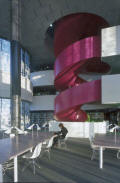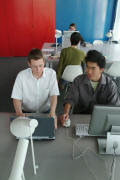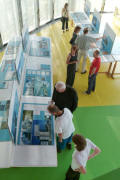New
technology
–
such as desktop publishing and internet, notebook and
wireless recording methods, email and mobile phones
– has clearly altered
research, teaching and study strategies. Today, the availability and use
of data, in regards to both information and content, takes place through
a variety of working platforms, carrier systems and access channels.
Integration, convergence and networking are the keywords of this
development. Modern forms of supplying information and media require
integrated services. In the digital age, new technical features and
redesigned organizational patterns are often quite abstract and
technocratic. However, there is also an increasing demand for
accessibility and transparency, corresponding the world of digital
information and the media. Architecture and design have gained a new
role with customers, clients, share- and stakeholders as well as users
and staff. The functionality of a building, influenced by its technology
and ‘fictionality,’ shapes the building and its rooms, such as in the
new ICMC/IKMZ. Visiting the center offers a technological adventure and
a new look into how the gap can be closed between organization and
technology and visitor experience and sensuality.
What are the organizational and technical aims and objectives for
the ICMC/IKMZ as a new central institution for academic support? With
the developments mentioned above, the suppliers of information and media
within the universities are presented with new tasks. Concretely, the
infrastructure – including the library, the multimedia center, the
computing center and the department for administrative data processing –
are most affected. For the ICMC/IKMZ (as an institution) these
challenges were often encountered, due to the new development in this
area. The new integrated service offers workers a step-by-step method
tracking both new and old users, while staying abreast of current
requests and issues. One can find these elements in the ICMC/IKMZ, which
caters to researchers, teachers, and students from the university and
also to local residents and the greater region. Users have access to
digital information and communication media, as well as computer
workstations, production tools, and network access points.
New services also require new forms of organization and
co-operation. Integrated services, found in the new building, require,
as a prerequisite, close co-ordination and co-operation between the
service provider and the service user. In 2004, the founding of the ICMC/IKMZ,
the library, the multimedia center, the computer center and
administrative data processing were brought together under a single
management system, covering both the budget and staff responsibilities
for the areas mentioned. With this consistent integration model, Cottbus
University is one of the few universities in Germany, which have, up
until now, decided to follow this path. Other comparable examples within
Germany include the integration proposals from the universities in
Oldenburg and Ulm[2].
2. The Answer of the ICMC/IKMZ-Building
How does one combine this organizational and technical approach with
the experience at the ICMC/IKMZ? The heart of the ICMC/IKMZ includes a
new building, in which the library and the multimedia center are housed;
the areas of 'operational data processing' and 'computing center' – also
belonging to the IKMZ/ICMC, however are not housed in the ICMC/IKMZ but
are at different locations on the university campus. The architecturally
imposing and, at the same time, functionally oriented building was
designed by the Swiss architects Herzog & de Meuron[3],
and was
finished
in November 2004, after a three year construction phase and a 6 year,
sometimes long and very difficult, planning process. The result of this
process was an exceptional architectural building, which matched the
mission of the space, providing different facilities and
interdisciplinary services for modern learning, teaching and research.
The architectural features provoked national and international
attention: 10,000 persons have visited the building since its opening in
2005/2006. The big number of reviews (articles, books, journals) also
reflects this tremendous interest.
The building, which stands in the eastern part of the BTU campus,
between the University and the city, is a 32 meter high, reinforced
concrete construction, covered by a double-shell glass facade embossed
with stylized graffiti. The ground plan of the building has a curved
outline resembling a cloverleaf, which does not explicitly have front
and back sides. The central space for public use is 7,630 m² - 5,461 m²,
976 m² for the administration, and 1,193 m² for the closed stacks[4].
Altogether, the new building has more than 700 workstations available.
The amazing external architecture continues internally with a spiral
staircase, extending from the 1st to the 6th floor, along with a
striking color scheme (in vibrant yellow, green, magenta, red, and blue)
for parts of the floor covering and walls.
In addition, a further characteristic of the building is that within
the ground plan none of the floor plans are the same. With the exception
of the management and business areas on the 7th floor and the technical
and pool areas in the two underground levels, there are only a few truly
separate areas. This allows a flexible and open concept for the use of
the building, which consciously allows for many work and communication
forms for both single and group users. The work and reading areas are in
coves related to each of the floors, while the open access stacks of the
library – floor specific – are arranged according to subject areas are
located in the core of the building.
The library, with its underground stacks and the specialized
libraries distributed over six floors, is the focal point of the
building's use: The individual specialized libraries are distributed
over the various floors as follows with open stacks:
Special library 1: Arts, Economics, Law (1st underground level and 2nd
floor);
Special library 2: Architecture, Civil Engineering, Technology (3rd and
4th floor);
Special library 3: Natural Sciences, Environment, Informatics (Computer
Science) (5th and 6th floor).
The multimedia center occupies the 1st floor, with its facilities for
multimedia production as well as for tele-teaching and tele-learning
environments. On the ground floor, there is a checkout desk, a service
counter for all services of the ICMC/IKMZ and an exhibition area. In
addition, on their appropriate floors, are the individual helpdesks for
the specialized libraries as well as printing, copying, and scanning
stations. Moreover, on the 1st underground level, computer labs and
presentation rooms provide various possibilities for multimedia
functions. On the 2nd underground level those stacks are located, which
are closed for the public (Mittler 2006, Warnatz, 2005).
An
important precondition for the supply structure in the new building is
the network based access system. This is a modern, high capacity system
based on a complete glass fibber infrastructure from the centre to the
individual workstations.
3. The Bigger Picture of Service
The integration approach will be carried through on both the technical
and organizational levels (Degkwitz, 2005/2006). The technical
integration is related particularly to the areas: archiving and back-up,
homogeneity of the basic data of university staff and students, mail and
web services, unification of the use of operating systems and software.
In this way – within the limits of what is technically possible and
maintainable – redundancies in the hardware and software areas, as well
as data storage, will be avoided and, at the same time, a long-lasting
standardization of the basic services will be aimed at. The
organizational integration will embrace services in which individual
activity areas intersect and/or in which at least two activity areas
participate such as: authentification and authorization serves, filing
and storage services, as well as production and publication services
(Degkwitz, 2007).
But the integration approach is also presented in the building and
its spaces, which invite students and researchers to work both
individually and in groups. On the 6th floor there are 18 cabins
(carrels) for graduate students. In the pool areas, which are located in
the 1st underground level and in the multimedia center, one can find a
well equipped computer room, for computer based courses and training as
well as for multimedia presentation and videoconferencing. But even in
the many reading rooms on the different floors, users have the
possibility to work as individuals or in groups. Though the large
variety of spaces, both in location, technology and size, users can more
adequately fit their communication and working needs without special
orders or regulations.
The ground floor is partly used as an area for exhibitions of
faculty projects or external partners. As well, the large reading rooms
can be prepared for conferences and social events. Because of the
openness and the transparency of the different floors it could be said
that the building is too noisy to work in concentrated and silent
atmosphere. But the readers and users don’t seem to be disturbed by the
possible influences of noise. On the one hand there are places and rooms
enough to find everyone’s proper environment. On the other hand it might
be a matter of practice and preference.
Thus, within the framework of the service development of the ICMC/IKMZ,
matrix-like organizational structures are used, which should guarantee
the necessary flexibility for the permanently changing user and service
demands. Since 2006 the following teams have been established recruited
from different departments of the ICMC/IKMZ:
Team 1: Public relations and budget planning;
Team 2: Front-Office;
Team 3: Innovation-Office in cooperation with the project elearn@btu[5];
Team 4: Content and Data Management;
Team 5: Consolidation of systems.
The teams report to the director of the ICMC/IKMZ and to the
regularly meeting executive board of the ICMC/IKMZ, which includes the
director of the ICMC/IKMZ and the heads of its departments.
4.
Conclusion
The
charm of the building is found in its shape and colours. Nobody has to
be afraid of the yellow, green, magenta, red and blue colours of the
floors, the walls—opening up the new world of media. There is no
‘cultural gap’ between this signature of the building and the work of
its users. The building and the concept has been awarded a “Place of
Ideas” in the campaign ‘Germany – land of ideas,’ in correlation to the
soccer world championship 2006[6]
and ‘Library of the Year 2006’, the national library award of the ZEIT-Foundation
Ebelin and Gerd Bucerius and the German Library Association[7].
The conjunction of "living" spaces, state of the art technological
equipment and integrated services creates an atmosphere of cultural
growth and inspires new ideas from all who encounter the building. Is
there anything else, that could close the gap
between organization, technology and sensuality more effectively?
*******
Many thanks to Ralf Schuster (ICMC/IKMZ) for the photographs. All the
rights for the pictures are reserved by the ICMC/IKMZ of the Brandenburg
Technical University of Cottbus.
ICMC/IKMZ in the WEB:
www.tu-cottbus.de/ikmz
References:
Bibliotheca Universitaria de Cottbus. El Croquis: Herzog & de Meuron
1998-2002, (2002), 210-219.
Degkwitz, A.: Neue
Anforderungen an die Informationsinfrastruktur von Hochschulen.
Bibliothek – Forschung und Praxis 29 (2005) 3, 353-359.
Degkwitz, A.: The
Building of the Information, Communication and Media Center (ICMC) /
Informations-, Kommunikations- und Medienzentrum (IKMZ) of the
Brandenburg Technical University / Brandenburgische Technische
Universität (BTU) Cottbus, in: LIBER Quarterly (2006) 16
Degkwitz, A.: Convergence in Germany. The Information-, Communication-
and Media-Center (ICMC/ IKMZ) of Cottbus University.
Library Hi-Tech
(2006) 24, 430-439.
Degkwitz, A.:
Informationsinfrastrukturen im Wandel. Informationsmanagement an
deutschen Universitäten / Changing Infrastructures for Academic
Services. Information Management in German Universities, hrsg. und mit
einer Einführung versehen von Andreas Degkwitz und Peter Schirmbacher. –
Bock + Herchen, Bad Honnef, 2007, 383 S. mit graph. Darst. und Abb. –
elektronischer Zugang unter:
http://www.dini.de/documents/DINI_Informationsinfrastrukturen.pdf
Hänel, K; Ache, R.;
Wetzel, A.: Energieversorgungskonzept für den Neubau der
Universitätsbibliothek der BTU Cottbus.
Forum der
Forschung (2002) 14, 77-80.
Mittler,
E.: Changing Needs - Changing Libraries. Documentation of new library
buildings in Europe, ed. by Elmar Mittler for the LIBER Architecture
Group Seminar, Utrecht and Gent, 20-25 March 2006.
Göttinger
Bibliotheksschriften 34, Niedersächsische Staats- und
Universitätsbibliothek Göttingen, 2006, 87-110.
Tanneberger, S.: Das
Informations-, Kommunikations- und Medienzentrum (IKMZ) der
Brandenburgischen Technischen Universität Cottbus. Bibliothek, Forschung
und Praxis (2003) 27, 69-71.
Warnatz, A.: Eine
Medienburg aus Glas und Beton.
BuB (2005)
57, 349-354.
Notes:
[1]
To the architectural idea cf. Herzog & de Meuron, 2002.
[2] s. the integrated
institution IBIT of the University of Oldenburg under
http://www.uni-oldenburg.de/projekti3sic/,
and the communication and information center of the University of Ulm
under
http://kiz.uni-ulm.de/.
[3]
About
the planning and the process of the construction cf. Tanneberger, 2003.
To the air condition and energy concept cf. Hänel, 2002.
[4]
More
detailed information about the building of the ICMC/IKMZ given to the
answered questionnaire of the LIBER Architecture Group cf. Mittler 2006.
[5]
s.
http://www.tu-cottbus.de/projekte/de/elearnbtu/
[6]
s.
http://www.land-of-ideas.org
[7]
s.
http://www.bibliotheksverband.de
















